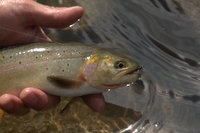Turning up the Heat on Fish
It was almost noon last Saturday when we finally launched the canoe on the Henrys Fork below St. Anthony—noon and already a scorcher of a day. As the sun beat down, I envied the fish swimming in the cool waters assuming that the heat couldn’t possibly affect them.
But water temperature can monkey with just about every aspect of a fish including; growth, development of embryos, and timing of life history events, and is a major factor in determining which fish can live where. For instance, the Snake River warms so much from top to bottom that the entire aquatic ecosystem changes.
In the headwaters, native cutthroat trout rule. This trout demands icy cold clean water and temperatures are coldest up high, where cutthroat thrive. As the river runs toward the valley floor it begins to warm. Research has shown that when the water temperature reaches 20 degrees Centigrade, the non-native rainbow trout gains the upper hand in competition with the cutthroat. Brown trout, the trout species most tolerant of higher temperatures, begin to occasionally show up in the creel here. By the time the Henrys and the South Forks of the Snake hit the valley floor the water has warmed significantly. Brown trout now predominate and few cutthroats can be found.
But the story doesn’t end there. The Snake River continues across southern Idaho gaining in size, strength, and temperature. Where the river runs past Swan Falls Dam south of Kuna, it is warm enough to support largemouth bass and other warm water fish. Invasive carp thrive, but trout only live in the deepest pockets where temperatures are still below the lethal level.
This same phenomenon can be seen in any Idaho water. Cold pure waters hold trout—when conditions that provide that environment change, the fishery changes. If there are trout species present other than the native cutthroat, the first indication of change will be increasing numbers of the non-native trout while cutthroat numbers decline. Eventually, if conditions become too tough for even the hardy brown trout, warm water species such as bass and crappie or rough fish, such as Utah chubs or carp, may ultimately dominate the system.
Stream waters warm naturally as they flow downhill. However, there are also many man-caused reasons why in-stream temperatures climb:
· Sediment, solids suspended in the water, absorbs more solar radiation.
· Low-head dams slow the water and increase exposure to the hot sun.
· Removal of overhanging trees and grasses reduces shading which is really critical during hot summer days.
· Irrigation re-charges the river with water warmed as it spreads across fields.
· Bank trampling changes the shape of the channel from deep and undercut to wide and shallow, again increasing the effects of solar radiation and destroys cold refugia.
Many of these impacts are reversible though, and with care, a trout stream can return to former glory relatively quickly.
After a few hours in the heat, I gladly climbed into the climate controlled comfort of my pick-up. I realized then that fish aren't so lucky. When their world heats up, there is no escape.

Fish, like this cutthroat trout, are highly sensitive to changes in temperature. Anything we can do to maintain cool summer temperatures in streams will benefit cold water species.